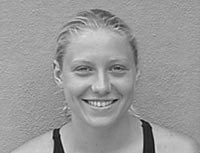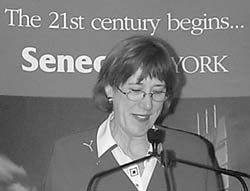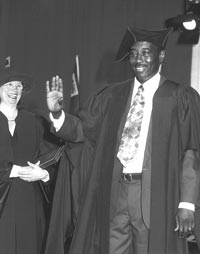
|

|
| | |
| | VOLUME 30, NUMBER 4 | WEDNESDAY, OCTOBER 6, 1999 | ISSN 1199-5246 | | |
| | ||
|
|
By David Finestone President Lorna Marsden welcomes Seneca to the York Campus We have reached the latest milestone in the continuing partnership between York University and Seneca College. After three years of planning and construction the Seneca@York campus was officially opened on Sept. 9. The building, designed by renowned architect Raymond Moriyama, captures the individuality of Seneca while maintaining continuity with York's architectural image. It boasts a three-level Learning Commons, a gymnasium with a running track and a one-stop area for student services. Invited guests representing Ontario industry, education and government were treated to a courtyard reception featuring speeches by York University President Lorna Marsden, architect Raymond Moriyama, Seneca College President Stephen Quinlan and Post-Secondary Education Minister Dianne Cunningham. Marsden welcomed Seneca to the York campus and community, and applauded the insight of those who had conceived the plan and those who had worked so diligently over the years to see it to fruition. She was appreciative, as well, of the "business" relationship between the two institutions which afforded York the opportunity to build its new computer science building, and reflected that many more buildings will be needed to meet the needs of the expected increase in student population over the next 10 years. Rather than cutting a ribbon, Quinlan used a mouse "click" to launch a video presentation that highlighted the stellar technical, educational and ergonomic qualities of the campus. These qualities will usher in a new era of education where the analytical strengths of York University congruently blend with the technical skills and training of the Seneca experience. Following the ceremonies, guests were invited to tour the state-of-the-art teaching facility that houses Seneca's Schools of Communication Arts, Computer Studies, Biological Sciences and Applied Chemistry and take in presentations of ongoing research projects. Information about Seneca@ York history and programs can be found on the Seneca Web site at www.senecac.on.ca.
| |
|
|
By Susan Scott Imagine you're studying a course through the Internet and you want to copy some of the online material your instructor has attached. Or you are the instructor of the online course and would like to post some relevant articles written by another scholar into your Internet course site. What if you're the writer of an article that someone else wants to reproduce onto the Internet. What rights does each of these individuals have? Sound confusing? Those were just some of the issues with which attendees to a seminar at York grappled this past summer. The seminar was co-sponsored by CulTech, the University's research centre focusing on the increasingly intertwining issues of culture and technology, and the US consular office in Toronto.
Legal, industrial and academic copyright experts tried to sort out issues at the seminar; of these about 30 people attended in person and another 135 tuned in online. Keynote speakers were Andrew Martin, executive director of CANCOPY, the Canadian Copyright Licensing Agency; Frederic Haber, general counsel of the US Copyright Clearance Center; John Vaughn, executive vice-president of the Association of American Universities; and Glen Bloom, copyright lawyer for the law firm, Osler, Hoskin and Harcourt. "We didn't come up with a lot of answers, just a lot more questions," said Don Berkowitz, CulTech's executive officer. "One of the problems is that the Internet doesn't respect national borders. But, it's okay for a student in the US to copy information, and it's not for a student in Canada." The increasing number of educational institutions offering distance education through the Internet challenges educators, users and creators of learning materials to find ways of handling the sensitive issue of copyright. Berkowitz explained that there's a difference between copyright laws in the US and Canada on this point. In the US, the law uses the concept of "fair use". This essentially means it's okay to copy teaching materials for use in a course; users are not financially penalized. In Canada, however, copyright laws use the "fair dealing" concept. It's against the law here to copy materials. Speakers at the seminar discussed how to strike a balance between these seemingly divergent viewpoints. The real challenge, he says, is trying to "determine what's fair and in the best interests of all parties. That includes the people who have developed the valuable material, and those who want access to it. How do we do that?" Berkowitz used an example of a compact disc buyer and the rights that buyer has. "Basically, all the user can do is listen to it, burn it or sell it. He or she can't, for instance, copy music onto another disk, nor copy or resell copies of the disk. Most people have no idea what rights they have, or more accurately, don't have." He suggested that faculty members at York, and elsewhere, should be educating themselves about this issue and getting involved in the debate, whichever argument they favour. CulTech is working on a couple of proposals to further investigate this whole matter including one it intends to submit to the provincial government. Berkowitz said if it's approved, he'll have more to say over the next several months. Other activities include collaborating on projects with other like-minded organizations. Again, Berkowitz said these are in the preliminary stages. However, his group and others are determined to keep the issue in the forefront and hopefully "shorten the time frame" for an eventual resolution. CulTech is a non-profit research centre established in 1992. The name combines the words "culture" and "technology" and the centre emphasizes the primacy of people over technology. CulTech researchers understand that while technology can enable change, only people can change the world. Its research focuses on the impact of technological change by designing and building testbeds and prototypes that challenge the status quo.
| |
|
|
The 40th Anniversary Steering Committee continues a call for nominations for awards honouring the founders of York University. The 40th Anniversary Founders' Society may include students, faculty, staff, administrators, board members, and community and provincial representatives who made a major contribution to York during its founding years (1957-1965). These awards will be presented on numerous occasions during the 40th anniversary celebrations until March 25, 2000.
Nominations for this award should include the name of the candidate, with a brief description (3-5 short paragraphs) outlining the contributions made to the founding of York University. Nominations will be reviewed by the steering Please send nominations to:
Gary J. Smith
| |
|
|
By Nishat Karim York University has four categories of annual University-Wide Teaching Awards that it presents for excellence in teaching. This Gazette series will continue to showcase each of the 1999 recipients from the categories of senior full-time faculty, full-time faculty, contract/part-time faculty, as well as teaching assistants. Presented during convocation, these awards are sponsored by the York Parents' Association and the recipients are selected by the Senate Committee on Teaching and Learning. Ibrahim Badr He is able to establish an open, comfortable and highly effective environment for active learning in all of his classes, based on mutual respect and commitment to meeting each student's needs. For this sincere dedication to teaching, Professor Ibrahim Badr has been selected as the recipient of the 1999 Parents' Association University-Wide Teaching Award for Contract/Part-Time Faculty. Badr is an accomplished motivator and mentor who incorporates modern technical aids with a broad range of teaching strategies, all centred in his unwavering belief in the importance of direct interaction with students. He is consistently noted as an "extraordinary teacher", ranking in the top category on student evaluations for his enthusiasm, patience, accessibility and his capacity to make the most difficult learning material easy to understand. As a colleague once said, he has earned respect for his "exceptional, unique and multifaceted contributions to the Department of French Studies and for his absolute commitment to undergraduate teaching."
| |
|
|
By Mel Blake The news that the Mars Climate Orbiter, a probe that cost $125 million US has apparently crashed into the surface of Mars has just been reported. Many people were astounded at the cost of the mission, and also questioned the value of such a program. After all, there are many problems facing humanity here on earth: we have problems with natural disasters, wars and feeding people. Why waste precious resources on scientific adventures that seem to have little or no value to everyday life? The sun is a fairly normal star, which is about 4.5 billion years old, shining through the atomic reactions in its core that convert hydrogen atoms to helium atoms, releasing copious energy in the process. The energy from these reactions heats the gases that make up the sun, preventing it from collapsing due to its own gravity. In another 5 - 6 billion years, the sun will run out of hydrogen in its core, causing the central region of the sun to contract, releasing energy. This will cause the outer regions of the sun to expand, making the sun into a large, cool star burning helium into still heavier elements. At this time, the radius of the sun will be about the same as that of the orbit of Venus. The Earth will be uninhabitable. Eventually, the helium reactions in the core of the sun will cease, and the outer layers of the sun will be ejected into space, while the sun becomes a dense, hot star called a white dwarf. White dwarfs emit large amounts of UV radiation, the same light that causes skin cancer. Life on Earth, if not already wiped out, will be destroyed by this energy. Clearly, while the sun is a fairly stable energy source at the present time, humanity must leave the earth and move to other habitable places if it is to survive. Species that are able to inhabit many different environments are more likely to endure, and so it is important that we explore Mars and other environments and learn to live in them. Otherwise, humanity will not survive and all the achievements it has made will be lost when the earth becomes uninhabitable. Imagine all the great works of art, all the great novels and poetry lost because we are not prepared to spend money now. The failure of the Mars Climate Orbiter is simply a reminder that most great endeavors are not risk free, and sometimes setbacks occur. October Celestial Highlights: This October is a great opportunity to view the planets Jupiter and Saturn, which are seen in the southern sky most of the evening. The planet Venus may be seen by early risers as a brilliant white object in the east about an hour before sunrise. York University Observatory is open to the public every Wednesday night throughout the year. For detailed information regarding opening times check out their Web site at: www.astro.yorku.ca/~delaney. Mel Blake is a doctoral student in astronomy and physics at York University.
| |
|
|

After scoring the winning goal to advance her team to the gold medal match against Australia at the Junior Women's World Water Polo Championships in Sicily, York student Christi Bardecki and her teammates finished the August competition with the silver medal the highest placing of any Canadian junior team at this international meet. The final score was 8-3 in the match held in Messina, Sicily, and Bardecki scored one of the Canadian goals. She also scored four goals in the quarter-final victory against Germany and three goals in the semi-final win over the Hungarian team. Overall, she had 15 points during the tournament to place in the top 10 scorers. Bardecki, who has just completed her second year at York, is a member of the York Mavericks Water Polo Club. She's been playing water polo since her high school days at York Mills Collegiate. Once at York, she led the University's varsity women's team to back-to-back final four appearances in 1998 and 1999 being named tournament MVP when the York squad won the varsity title in 1998.
| |
|
|
Abella new president of Canadian Historical Association Irving Abella, the J. Richard Shiff Professor of Canadian Jewish Studies at York, has been acclaimed president of the 1,000-member Canadian Historical Association (CHA). He is the first Jewish head of the organization in its 85-year history. The CHA is the national representative body of Canada's historians and is dedicated to research and scholarship in all fields of history. Abella is the author or co-author of seven books, including None is Too Many, the fifth edition of which will be published in spring 2000. He is the past national president of the Canadian Jewish Congress, a recipient of the Order of Canada and a fellow of the Royal Society of Canada. Theatre prof named first Canadian chair of international theatre technology commission John Mayberry, an assistant professor of theatre production at York's Department of Theatre, is the new Chair - and first Canadian - of the Technology Commission of the International Association of Scenographers, Theatre Architects and Technicians (OISTAT). In fact, Mayberry is the first Canadian named Chair in the six OISTAT commissions. The commission links theatre technicians, manufacturers and suppliers around the world. OISTAT is an international umbrella organization with centres in 37 countries working to promote the sharing of information on all aspects of theatre design, technology and architecture.
| |
|
|
By Cathy Carlyle Diane Hammond is a consultant to the YES I Can! Science Project. She updates science-related expeditions and coordinates live links with those on the expeditions for students and teachers. The YES I Can! Science Project - a computer resource database - seems to be becoming more of a "Yes Please, Yes Please!" project. Its popularity has leaped forward since it became located at York University last September after having started at the Simcoe County District School Board. In April and May alone there were 80,000 hits at the Web site, to be found at www.yesican.yorku.ca. "These hits are not just people who have clicked onto our Web site," said Susan Stiff, project manager. "We measure only those who come into the Web site past the main page and actually do some work in it. This is a great statistic for us at York. We didn't expect to be as far ahead as we are, after only a year. I think we have an excellent reputation now. We've been spreading the word at conferences that we are unique." She and husband Tom, the main coordinators of the database [Tom is also a YES I Can! consultant], see their project as an invaluable resource for science teachers and students across Canada, though they say that some of the Web site visitors are from as far away as Japan, Taiwan, Singapore and Australia. The Internet-based teaching and learning resource, which is targetted mainly to elementary and secondary level teachers to help them in lesson preparation, is now expanding to draw teachers and students into "expeditions". The Stiffs contacted Dr. Pascal Lee of NASA Ames Research Center after they heard about a multi-disciplinary investigation being planned at bleak Haughton Crater on Devon Island, Nunavut in the high Arctic last summer. "We saw a Canadian connection, and Dr. Lee agreed to give us information collected on his expedition, said Susan Stiff of the Haughton-Mars Project (HMP)."
It went further than that. The expedition leader made daily In 2000 the HMP research team at Devon Island has invited them to send someone from York - faculty, student or one of the YES I Can! team members - to design experiments and implement them at the site. "Just being asked is a thrill," said Susan, adding that she is not certain that the project will be able to fund such a venture. "If we cannot, they've said we'll be able to devise experiments that the team will carry out for us. Last year's HMP expedition was so exciting that National Geographic Magazine became involved as co-sponsors and as journalists to report events. Their article was published in the July 1999 issue. The cause of all the interest was the barren and remote Haughton Crater and surrounding area, and the similarity to conditions on Mars. The scientists conducted biological and geological research on the 20-km high impact crater with the hopes of better understanding the nature and evolution of the Red Planet. Ultimately, they hope to find answers to the questions of what happened to water on that planet and whether ice can be found at shallow depths there. Susan Stiff said that YES I Can!, though not widely known by York faculty, is gaining support from those at the University who are aware of its existence. Steve Alsop, professor in the Faculties of Education and Science, plans to have his students create resources to contribute to the database. "The course work that they do will be beneficial to us because of the information they'll provide. At the same time, it will give them experience for their portfolios when they apply for employment later."
| |
| | Current Issue | Previous Month | Past Issues | Rate Card | Contact Information | Search |
|


